First aid - Heat rash:
Definitions:
Heat rash — also known as prickly heat and miliaria — isn't just for babies. Heat rash affects adults, too, especially during hot, humid weather.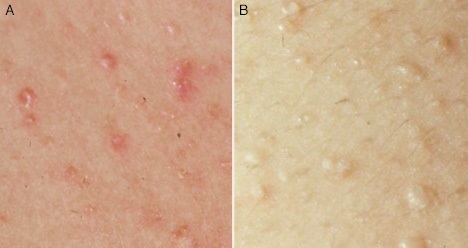
Heat rash develops when blocked pores (sweat ducts) trap perspiration under your skin. Symptoms range from superficial blisters to deep, red lumps. Some forms of heat rash feel prickly or intensely itchy.
Heat rash usually clears on its own. Severe forms of heat rash may need medical care, but the best way to relieve symptoms is to cool your skin and prevent sweating.
Miliaria rubra (A), one type of heat rash, appears as red clusters of small blister-like bumps that can produce intense itching. Miliaria crystallina (B), another type of heat rash, appears as clear, fluid-filled bumps that produce no other signs or symptoms.
Symptoms:
Adults usually develop heat rash in skin folds and where clothing causes friction. In infants, the rash is mainly found on the neck, shoulders and chest. It can also show up in the armpits, elbow creases and groin.
Heat rash usually heals by cooling the skin and avoiding exposure to the heat that caused it. See your doctor if you or your child has symptoms that last longer than a few days, the rash seems to be getting worse, or you notice signs of infection, such as:
- Increased pain, swelling, redness or warmth around the affected area.
- Pus draining from the lesions.
- Swollen lymph nodes in the armpit, neck or groin.
- A fever or chills
Causes:
Heat rash develops when some of your sweat ducts clog. Instead of evaporating, perspiration gets trapped beneath the skin, causing inflammation and rash.
It's not always clear why the sweat ducts become blocked, but certain factors seem to play a role, including:
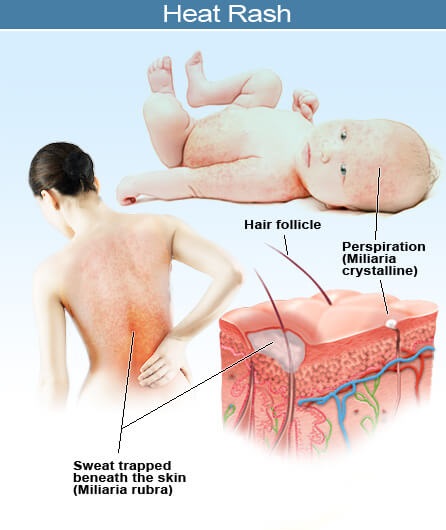
- Immature sweat ducts. A newborn's sweat ducts aren't fully developed. They can rupture more easily, trapping perspiration beneath the skin. Heat rash can develop in the first week of life, especially if the infant is being warmed in an incubator, is dressed too warmly or has a fever.
- Tropical climates. Hot, humid weather can cause heat rash.
- Physical activity. Intense exercise, hard work or any activity that causes you to sweat heavily can lead to heat rash.
- Overheating. Overheating in general — dressing too warmly or sleeping under an electric blanket — can lead to heat rash.
- Prolonged bed rest. Heat rash can also occur in people who are confined to bed for long periods, especially if they have a fever.
Risk factors:
Factors that make you more prone to heat rash include:
- Age. Newborns are most susceptible.
- Tropical climates. People living in the tropics are far more likely to have heat rash than are people in temperate climates.
- Physical activity. Anything that makes you sweat heavily, especially if you're not wearing clothing that allows the sweat to evaporate, can trigger heat rash.
Newborns, infants, the elderly, and obese individuals with large areas with skin-on-skin contact areas (for example, a large overlapping area of abdominal fat) are at risk for developing heat rash. They all are especially at risk if they are immobile for long periods of time and parts of the skin aren't exposed to circulating air, which results in the inability of the sweat ducts to "breathe" (evaporative cooling).
Heat rashes are more common in places with hot, humid, climates because people sweat more.
Sun rash:
Some people have skin that can develop rashes with exposure to direct sunlight including people on certain antibiotics, or people exposed to some chemicals, fragrances, dyes, or disinfectants. This is called photodermatitis.
In some people exposure to the sun in the spring or early summer can trigger an itchy, red rash on the front of the neck and chest and the arms and thighs called polymorphous light eruption (PMLE). It usually clears without treatment in a few days, although it can come back.
Skin allergies:
Spring and summer are times when there are many substances that can cause allergic skin reactions in the environment – molds, pollens, plant and animal substances. Hives (urticaria) can be triggered by heat or sweat. Eczema (atopic dermatitis) can worsen in the summer, especially with excess sweating. Certain plants and grasses can cause skin rashes.
Rashes from bites and stings:
Bites and stings usually cause pain and slight swelling, but they can cause a severe skin reaction in some people, particularly if they are allergic to stings. Sometimes the reaction is localised to swelling at the site of the bite or sting. This may be many centimeters wide but gradually goes away over a few days.
In some people the reaction to the bite or sting affects their whole body and can cause itchy skin anywhere on the body, swelling of the face, lips, tongue, throat, and upper airway, a fast heart rate and low blood pressure. A severe allergic reaction affecting the whole body is called anaphylaxis and is a medical emergency.
How is heat rash diagnosed?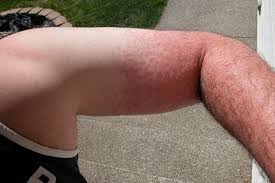
Heat rash can usually be identified by its appearance and does not usually require medical attention. But if it doesn't go away after 3 or 4 days, or if it appears to be getting worse, or if your child develops a fever, contact your doctor right away.
When you or your child has a rash, be sure to watch for signs of infection, including:
- Increased pain, swelling, redness, or warmth around the affected area.
- Red streaks extending from the affected area.
- Drainage of pus from the area.
- Swollen lymph nodes in the neck, armpit, or groin.
- Fever of 100°F (37.8°C) or higher, or chills with no other known cause.
If any of these symptoms develop, contact your doctor immediately.
Treatment for heat rash?
Most prickly heat rashes heal on their own. The following steps can help relieve symptoms.
- Start by removing or loosening your baby's clothing and move him or her to a cool, shady spot.
- Let the skin air-dry instead of using towels.
- If your baby's skin is irritable when touched, calamine lotion or hydrocortisone cream may be used with your doctor's approval.
- Avoid ointments or other lotions because they can irritate the skin.
The following tips can help prevent future episodes of the rash:
- Dress your child in as few clothes as possible during hot weather.
- Keep the skin cool and dry.
- Keep the sleeping area cool.
Heat rash home remedies:
Most heat rash resolves without treatment, often within a day after changing to a cooler environment.
The best way to prevent heat rash is to avoid sweating by staying in cooler areas, using fans and limiting physical activity.
The following self-care steps and remedies may help with heat rash.
First step: The first step in treating heat rash is to wash the affected area with a gentle soap (for example, Dove non-soap cleanser or something similar).
Next, rinse the area with water and gently pat dry with a towel. It is recommended to wash several times a day, especially after exercise, prolonged walking, or heat exposure.
- Remain in a cool environment and allow for adequate ventilation of the skin.
.jpg?timestamp=1466788164335)
- Take cool showers or baths
- Rest in an air-conditioned room at 70 F to 72 F (21 C to 22 C) is therapeutic. If no air conditioning is available at home, safe retreats include indoor shopping malls, grocery stores, movie theaters, hotel lobbies, ice skating rinks, bowling alleys, etc.
- Avoid skin-to-skin contact by placing a clean cotton washcloth or material between skin folds like under the breasts or abdomen.
- Apply cool packs over the affected areas (do not leave packs on longer than 20 minutes per hour).
Medical treatment for heat rash:
Heat rash or prickly heat resolves on its own once the skin cools, but on occasion the sweat glands can become infected. The signs of infection include pain, increased swelling, and redness that does not resolve. Pustules may form at the site of the rash. This infection occurs because bacteria have invaded the blocked sweat gland. Antibiotic treatment may be required. Chronic and recurrent heat rash may need to be treated by a health care practitioner or dermatologist (skin specialist).
Heat Rash Prevention:
Prevention is the most important treatment for heat rash; by allowing the skin to be exposed to circulating air, the potential for sweat ducts to become blocked and the glands to become inflamed decreases.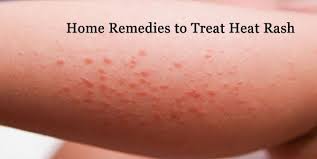
- Wear cool breathable fabrics such as cotton.
- Avoid polyester and nylon clothing.
- Maintain a comfortable room temperature with fans and air conditioning.
- Babies and infants should be kept comfortably cool and dry. Because of babies' and infants increased fat folds and diaper irritation, they frequently get rashes on their diaper area and abdomen folds (diaper rash).
- Infant drooling may cause further occlusion of sweat ducts and hair follicles leading to heat rash on the face cheeks.
- Bedridden and wheelchair bound patients should be rotated and moved to avoid constant sweating and occlusion in the same area.
How effective are electric fans in preventing heat rash?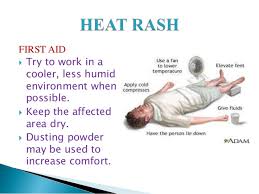
Keeping the skin cool on hot days is an important preventive measure. Air circulation (with fans or by other methods) usually will help with skin cooling. It is important not to bundle newborns and infants too tightly so that air can get to the skin, but it also is important to keep them warm enough.
It is important to move individuals who are immobile (for example, some elderly, those with paralysis, or are weak) so all parts of the body can be exposed to fresh air and help prevent tissue breakdown.
How can people protect their health when temperatures are extremely high?
The body can adapt very well in hot weather, but it takes time to acclimate. The actual temperature is just one factor when a person decides to work, play, or exercise in the heat. The heat index adds humidity to the equation since sweat cannot evaporate if the water content in the air (humidity) is high. If the air holds as much water as it can there is no place for sweat to go, and evaporation cannot cool the body.
To avoid heat-related illnesses, avoid working or exercising in extreme heat. If it is required, to avoid dehydration and other complications, take frequent breaks to get out of the heat and drink plenty of fluids to replenish fluid lost via sweat.
Early signs of heat-related illnesses include light-headedness, weakness, and nausea. It is important to get out of the heat, cool off, and re-hydrate immediately to avoid heat-related problems such as heat exhaustion and heat.
How much water should I drink in hot weather?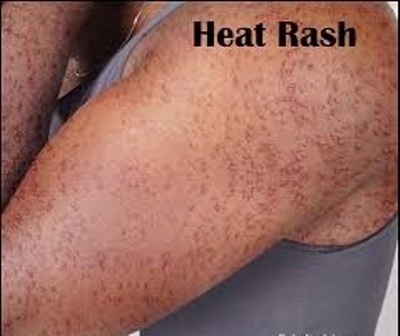
It is hard to gauge how much water is lost through sweat, and the thirst mechanism may not be sensitive enough to remind a person to drink enough. In general, the kidneys are a good guide to whether there is enough water in the body. If the body is dehydrated, the kidneys will try to hold on to as much water as possible. Symptoms and signs of the kidneys preserving water are decreased urine production, urine concentrated in colour, and a strong urine odour. Urine is clear when there is enough fluid in the body.
In a hot environment, a person should drink enough water to make the urine clear, and make sure the body is producing sweat.
Should I take salt tablets during hot weather?
Taking salt tablets is rarely a good idea. While the body loses many electrolytes when it sweats, there are mechanisms in place to compensate for the loss. Usually, keeping the body hydrated with plain water is adequate but does not resupply electrolytes. Sports drinks (for example, Powerade, Gatorade) may be reasonable alternatives.
What is the best clothing for hot weather or a heat wave?
Evaporation works to cool the skin only if the sweat that the body produces is allowed to evaporate. Lightweight, loose clothing allows air circulation to the body's surface and helps promote cooling. While cotton is the classic fabric that can be used, some synthetic fabrics have been developed to wick sweat from the skin and allow more efficient skin or body cooling.
What is the prognosis for heat rash?
Heat rash or prickly heat tends to be self-limiting and gets better once the skin cools and is allowed to breathe. Prevention by not allowing heat to accumulate in body areas, followed by cooling the skin are the most common ways to obtain the best prognosis for heat rash.
Heat Rash Do's
- Do get out of the heat.
- Do wear cool, breathable fabrics such as cotton.
- Do maintain comfortable temperatures with fans and air conditioning.
- Do wash off the skin with mild soap and pat dry after sweating or exercise.
- Do take a cool shower or bath.
Heat Rash Don'ts
- Don't wear polyester and nylon fabrics in the summer.
- Don't cover with ointments, Vaseline, or heavy creams.
- Don't scrub or rub the skin to remove heat rash bumps.
- Don't stay in the heat or humidity.
- Don't go in a hot tub, sauna, or Jacuzzi.
Different Heat rash images
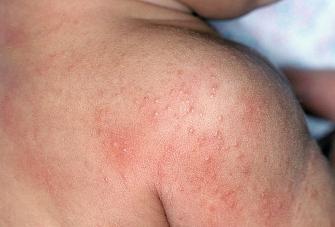
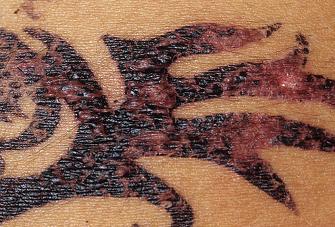
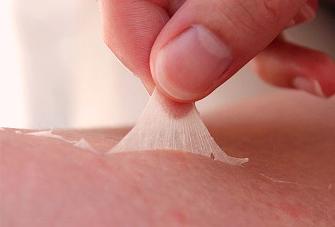
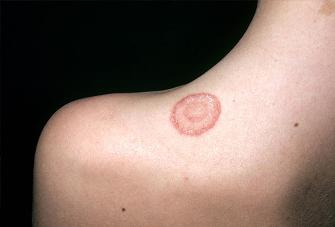
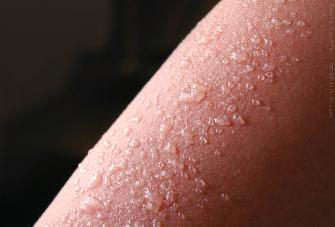
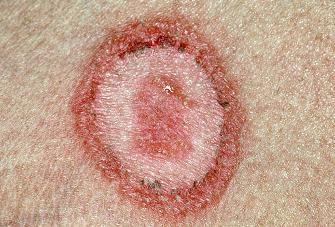
First aid video for Hear rash-1
First aid video for Hear rash-2